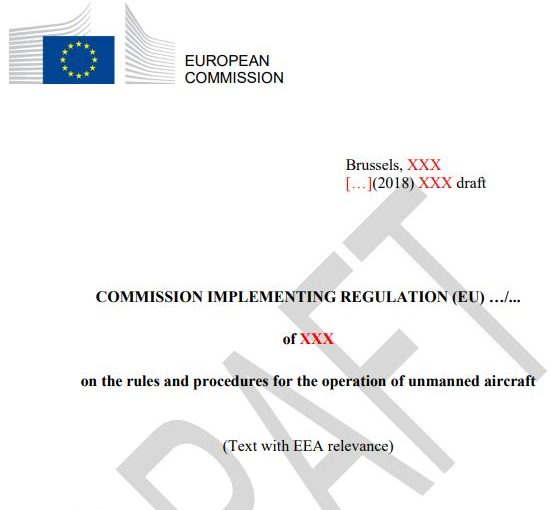The European Commission has published the Draft Implementing Regulation on the rules and procedures for the operation of unmanned aircraft, including key aspects of UTM service provision such as:
- Article 11 Rules for conducting an operational risk assessment
- Article 14 Registration of UAS operators and certified UAS
- Article 15 Operational conditions for geographical zones
- And Article 19 Safety information
Draft acts are open for feedback for four weeks and published on https://ec.europa.eu/info/law/better-regulation/initiatives/ares-2018-1460265_en. Stakeholders have until 5 November to express their views on the draft regulations. “Feedback will be taken into account for finalising this initiative,” says the Commission on its website. “Feedback received will be published on this site and therefore must adhere to the feedback rules.”
According to Peter van Blyenburgh of UVS International: “The basic concepts included in the EASA Opinion have been maintained, but some clarifications have been introduced, e.g a clearer boundary between specific and certified category; the level of information and requirements put on the drone manufacturers, the drone operators and the competent authorities have been increased including topics previously covered by AMC or GM; a few new requirements have been introduced (such as existing legal requirements related to the certified category or minimum age of the pilots).
Key new elements in the draft regulation, says Peter Van Blyenburgh, are that the risk assessment and authorisation procedures in the specific category have now been set out in detail, the “safe distance” to be kept in the sub-categories of the open Category are specified; the range of C0 class drones are reduced to 120 m to reduce the possible privacy impact; operations conducted in model aircraft clubs and associations remain under the national regulation; and the transition and applicability periods have been extended.
Previous feedback on the EASA Opinion which has formed the basis for these draft rules has been received by the Drone Manufacturers Alliance Europe (DMAE). The association has had several concerns – among them:
“We note the Roadmap mentions geofencing not geoawareness found in the EASA Opinion. DMAE asks for clarification. Already today some of our products use geofencing technology, which should be formally recognized as a means compliance with geoawareness requirements, provided systems are run on validated data by Member States. Geofencing systems currently on the market technically help prevent operators from having their drone enter highly sensitive areas (airports, prisons etc). DMAE urges Member States ensure geofencing solutions continue to be allowed on the market to realise the increased safety and security benefits these systems deliver.
“Call for more research: Drone rulemaking needs to be based on science and evidence. Throughout the EASA Basic Regulation discussion DMAE has called on EU lawmakers to adopt a 2kg registration weight threshold (in line with international standards). We call on EASA to launch and finance a research project on the risk profile of drones. The study should focus on the risk that drones at various weights pose to both manned aviation and ground risk. The study should explore what risk is socially acceptable. DMAE is ready to engage.
The association is also concerned that the authority bestowed upon Member States (MS) in the IR jeopardizes a single EU drone framework.
“MS will have authority to define airspace prohibitions and limitations. These zones may be established for safety, security, privacy, or environmental reasons under the EASA opinion. While the SORA process ensures consistency in safety assessments, there is no mechanism to ensure uniform evaluation of privacy, security and environmental impacts. The EASA opinion also states, “It is recognized that an authorization granted by the competent authority of the operator’s principal place of business may need to be adapted to the local conditions that may exist in another MS.” While EASA believes setting manner and format requirements for these restrictions will “ensure standardisation,” a standard process does not equate to standardisation. Any restriction should be required to be reasonable as to time, place and matter, and subject to public comment.”
For more information
Draft implementing regulation – Ares(2018)5119803
English (489.7 KB – PDF – 18 pages)
Download (489.7 KB – PDF – 18 pages)
Annex – Ares(2018)5119803/1
English (366.2 KB – PDF – 15 pages)
Download (366.2 KB – PDF – 15 pages)
Draft delegated regulation – Ares(2018)5119839
English (474.2 KB – PDF – 30 pages)
Download (474.2 KB – PDF – 30 pages)
Annex – Ares(2018)5119839/1
English (787.6 KB – PDF – 24 pages)




